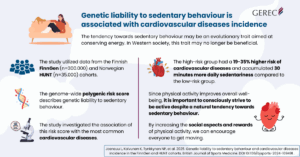Key words: public health, physical activity promotion, genetic epidemiology
Why is this study important?
Paleoanthropologists have previously argued that physical activity has long been a survival need in human history, which is why humans would not have evolved to move voluntarily (1). Moreover, sedentary behaviour may be a trait selected by evolution to conserve viable energy. Although the evidence is still mainly theory-based, human genetics may regulate sedentary behaviour (2) and underlie the commonly observed phenomenon of physical inactivity in the population. This may cause evolutionary mismatch where previously advantageous alleles cause morbidity in the current postindustrial environment (3). For the first time, we investigated the association between genetic predisposition to sedentary behaviour and cardiovascular diseases.
This blog is based on a recently published BJSM study (4).
How did the study go about this?
Genetic predisposition can be determined using modern genome-wide polygenic scores. We developed a polygenic score to describe genetic predisposition to leisure screen time, the most common type of voluntary sedentary behaviour. The polygenic score was used to investigate the association between genetic predisposition to sedentary behaviour and the incidence of all cardiovascular diseases, hypertensive diseases, ischaemic heart diseases, such as myocardial infarction as well as cerebrovascular diseases. The unique genome and health data of about 330,000 Finns from FinnGen was used in the research. The analyses were repeated in a separate reference group, which consisted of about 35,000 Norwegians.
What did the study find?
We found that genetic predisposition to sedentary behaviour was associated with an increased risk of cardiovascular diseases almost equally in both population samples. People with the highest predisposition to sedentary behaviour accumulated about half an hour more daily sedentary time and had about a 20% higher risk of developing the most common cardiovascular diseases, compared to those with the lowest genetic predisposition.
What are the key take-home points?
Our results support previous theories that the human trait to be sedentary has a genetic basis and illustrate its health associations. The feeling of not having the energy to exercise may therefore be completely normal. This presents a challenge for those promoting physical activity: how to effectively encourage physical activity in a population that may be biologically inclined towards sedentariness, and calls for new innovative approaches.

Authors: Laura Joensuu, Elina Sillanpää
Faculty of Sport and Health Sciences, University of Jyväskylä, Finland
Infographic created by Onni Hämäläinen
References:
- MacDonald C , Bennekou M , Midtgaard J , et al . Why exercise may never be effective medicine: an evolutionary perspective on the efficacy versus effectiveness of exercise in treating type 2 diabetes. Br J Sports Med 2025;59:118–25. doi:10.1136/bjsports-2024-108396
- Young DR, Hivert M-F, Alhassan S, et al. Sedentary Behavior and Cardiovascular Morbidity and Mortality: A Science Advisory From the American Heart Association. Circulation 2016;134:e262–79.
- Manus MB. Evolutionary mismatch. Evol Med Public Health 2018;2018:190–1.
- Joensuu L, Koivunen K, Tynkkynen NP, et alGenetic liability to sedentary behaviour and cardiovascular disease incidence in the FinnGen and HUNT cohortsBritish Journal of Sports Medicine 2025;59:783-790.